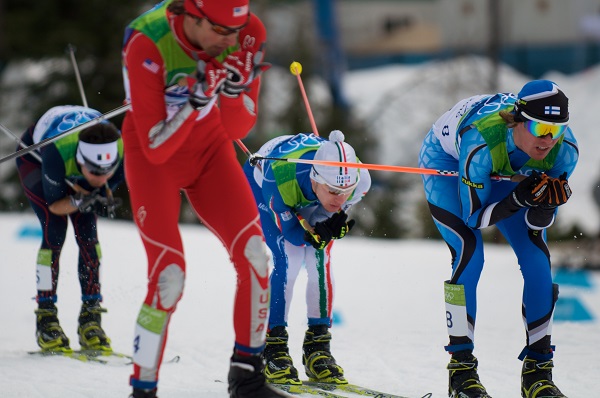Cross country skiing is a beautiful sport to watch. Although the courses are designed to have an equal amount of uphill, downhill, and level sections, they are often perched in pristine mountains and wind through old forests. It’s a picturesque and predictable sport that Olympics television producers take advantage of by staging simply gorgeous camera shots of. The only problem is, at least for me, it’s often hard to tell whether the skiers are going up a hill, down a hill, or neither. As anyone who has ever skied will tell you, the problem is that the white snow doesn’t lend itself to depth perception particularly well. So, the detail to latch onto in watching Cross Country Skiing is which way the skiers are going: up, down, or level.
This post is one in a series of posts about the Winter Olympics that arm the casual viewer with a single tactic to sound smart while watching each event. Focusing on these details may also make your viewing experience more enjoyable!
This distinction is complicated by the bifurcation of cross country events between classic and skate skiing style. In classic, skiers are only allowed to move their skies back and forth. In skate skiing, skiers are allowed to move their skies sideways. Skate skiing is newer and faster. If you know which technique a skier is using and you observe how she uses her poles and skies, you will be able to tell if she is going up, down, or sideways.
Skate Skiing
- Uphill: A skate skiing cross country skier who is going up a hill will have their legs turned way out. Their poles will be hitting the ground in a funny 1, 2… 1, 2…. 1,2 … rhythm.
- Flat: The same skier on a flat portion of the course will have their skies pointed more or less forwards but will be sweeping each ski outward in each stride. He will be using his poles in parallel, striking the ground with each at the same time.
- Downhill: Going downhill is the only time you will ever see a skate skiing cross country skier look like a classic skier. There’s just not that much of an advantage to moving your skies at all when you are going down hill. So, skis are completely parallel and poles are either used in parallel but less frequently than on a flat or not at all as skiers bend over into a tuck.
Classic Skiing
Distinguishing up, down, and flat for classic cross country skiing is harder. The limitations on how a skier may move her skies also limit the variety in technique that adapts to the pitch of the course. Still, with a little focus, it is possible.
- Uphill: A classic skier going uphill is a painful sight to see after watching how the skate skiers do it. A classic skier going uphill looks like she is running. As one leg pushes forward, the pole held in the opposite arm strikes the ground. Then the other and the other. It looks simply exhausting.
- Flat: On flat ground, a classic skier barely moves their skis at all. They look like they are being powered completely by their two poles which strike the ground at the same time.
- Downhill: The only way that I can see to distinguish between flat and downhill is that during a downhill, classic skiers mostly don’t use their poles at all. Instead, they get into an aerodynamic tuck.
Learning these clues to when a cross country sky race is going up, down, or sideways will help you enjoy the Winter Games and put you in the top five percent of educated viewers.
Thanks for reading,
Ezra Fischer

